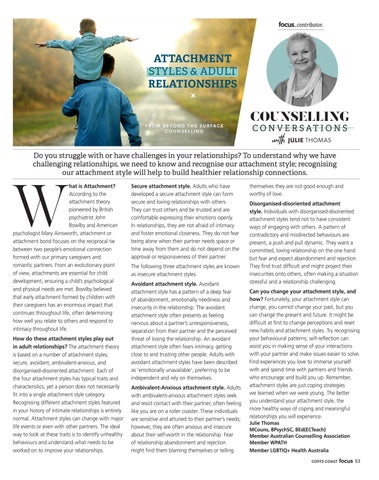focus_contributor.
ATTACHMENT STYLES & ADULT RELATIONSHIPS
F R O M BE YO N D T H E S U R FAC E COUNSELLING
COUNSELLING C O N V E R S AT I O N S
with JULIE THOMAS
Do you struggle with or have challenges in your relationships? To understand why we have challenging relationships, we need to know and recognise our attachment style; recognising our attachment style will help to build healthier relationship connections.
W
hat is Attachment? According to the attachment theory pioneered by British psychiatrist John Bowlby and American psychologist Mary Ainsworth, attachment or attachment bond focuses on the reciprocal tie between two people’s emotional connection formed with our primary caregivers and romantic partners. From an evolutionary point of view, attachments are essential for child development, ensuring a child’s psychological and physical needs are met. Bowlby believed that early attachment formed by children with their caregivers has an enormous impact that continues throughout life, often determining how well you relate to others and respond to intimacy throughout life. How do these attachment styles play out in adult relationships? The attachment theory is based on a number of attachment styles; secure, avoidant, ambivalent-anxious, and disorganised-disoriented attachment. Each of the four attachment styles has typical traits and characteristics, yet a person does not necessarily fit into a single attachment style category. Recognising different attachment styles featured in your history of intimate relationships is entirely normal. Attachment styles can change with major life events or even with other partners. The ideal way to look at these traits is to identify unhealthy behaviours and understand what needs to be worked on to improve your relationships.
Secure attachment style. Adults who have developed a secure attachment style can form secure and loving relationships with others. They can trust others and be trusted and are comfortable expressing their emotions openly. In relationships, they are not afraid of intimacy and foster emotional closeness. They do not fear being alone when their partner needs space or time away from them and do not depend on the approval or responsiveness of their partner. The following three attachment styles are known as insecure attachment styles. Avoidant attachment style. Avoidant attachment style has a pattern of a deep fear of abandonment, emotionally neediness and insecurity in the relationship. The avoidant attachment style often presents as feeling nervous about a partner’s unresponsiveness, separation from their partner and the perceived threat of losing the relationship. An avoidant attachment style often fears intimacy, getting close to and trusting other people. Adults with avoidant attachment styles have been described as ‘emotionally unavailable’, preferring to be independent and rely on themselves. Ambivalent-Anxious attachment style. Adults with ambivalent-anxious attachment styles seek and resist contact with their partner, often feeling like you are on a roller coaster. These individuals are sensitive and attuned to their partner’s needs; however, they are often anxious and insecure about their self-worth in the relationship. Fear of relationship abandonment and rejection might find them blaming themselves or telling
themselves they are not good enough and worthy of love. Disorganised-disoriented attachment style. Individuals with disorganised-disoriented attachment styles tend not to have consistent ways of engaging with others. A pattern of contradictory and misdirected behaviours are present, a push and pull dynamic. They want a committed, loving relationship on the one hand but fear and expect abandonment and rejection. They find trust difficult and might project their insecurities onto others, often making a situation stressful and a relationship challenging. Can you change your attachment style, and how? Fortunately, your attachment style can change, you cannot change your past, but you can change the present and future. It might be difficult at first to change perceptions and reset new habits and attachment styles. Try recognising your behavioural patterns; self-reflection can assist you in making sense of your interactions with your partner and make issues easier to solve. Find experiences you love to immerse yourself with and spend time with partners and friends who encourage and build you up. Remember, attachment styles are just coping strategies we learned when we were young. The better you understand your attachment style, the more healthy ways of coping and meaningful relationships you will experience. Julie Thomas MCouns, BPsychSC, BEd(ECTeach) Member Australian Counselling Association Member WPATH Member LGBTIQ+ Health Australia COFFS COAST
focus
53






